The Inchview boys are in town
In 2015 the football club created a huge banner which is displayed in the North Stand at Firhill and shows the Thistle team from 1888-89, and I bestowed on the team members the honour of now being honorary season-ticket holders.
Inspired, I took the opportunity of writing ‘pen pics’ of each of the team which were originally published on the We Are Thistle forum and I’m delighted to republish them here, too.
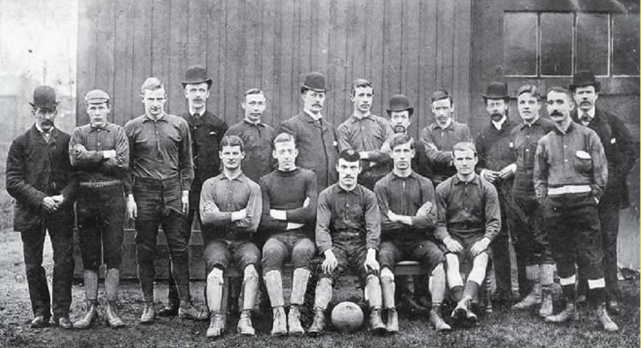
standing: Frank Burns (trainer), John McCorkindale (goalkeeper), David Hislop (forward), William Stirling (ex-player, Vice-President), Andrew Mackay (forward), John N. Boag (ex-player, President), William Proudfoot (half-back), Charles McQuarrie (ex-player, Treasurer), J. Kelly (forward), Andrew M. Smith (Honorary Secretary), John Drummond (forward), John Hendry (full-back), Jerry Suter (forward, Match Secretary)
sitting: Bob Robertson (half-back), William Hay (full-back), Andrew Johnston (forward), Thomas Campbell (full-back), George Ward (half-back)
4 times we played Rangers this season. Unfortunately, we lost the big one; 2-4 in the Scottish Cup at Old Ibrox in September, but three subsequent victories softened the blow:
13.10.1888 Rangers [h] W2-0 scorer: Willie Paul (2)
09.02.1889 Rangers [a] W4-2 scorers: Jerry Suter, Willie Paul (2), Andrew Johnston
04.05.1889 Rangers [h] W6-2 scorers: Bob Robertson, Jerry Suter, Walter McLean, ?, ?, ?
This “treble” still stands jointly as the club record today, having been matched four times since – in 1904-05, 1914-15, 1934-35 and 1950-51.
 |
Frank Burns (trainer) Burnsy looks like a real man’s man, but it’s to be hoped he didn’t turn up for training dressed like that. Mrs. B. would have went totally ape. And I’ll tell you what, milk wasn’t his favoured tipple, that’s for sure. All japes aside, it must be assumed that Mr. Burns was very good at his job, for he was still in place in 1896-97 and he goes down in history as the man who trained the first title-winning Partick Thistle side. I’m feeling a strong kinship with the Lambini here, and for all of these reasons combined, I’m personally voting for Frank as my joint-favourite of our new season ticket holders. |
 |
John McCorkindale (goalkeeper) Corky, who looks like he’s having his first school photie being taken against his will, had previously played with our great rivals, Partick FC, but really made a name for himself as the No.1 for the Thistle of the Pertyck. He appeared at least 132 times, from March 1888 through to January 1892, and was around long enough to play in the inaugural Scottish Alliance of 1891-92 – our very first League campaign. In February 1890, he was selected by the Glasgow FA to play against the East of Scotland FA, which Glasgow won by 3 goals to 2. He played 3 times for Glasgow in all. Our man brought great honour to the club when he became the first Thistle goalie to play for Scotland. His one and only cap came on the 21st March 1891 when he was reportedly kept very busy at the Racecourse Ground; Wales 3, Scotland 4. As was the norm in the days of the amateur, John occasionally guested for others, including Rangers. We’ll no’ hold it against him though; the wee feller done us proud in his time at the club. Halfway through season 1891-92, he was finally tempted away from Inchview by Clyde, who were able to offer him something we couldn’t – a platform in the second season of the Scottish Football League. John is one of the super seven who contributed to all three victories against Rangers in season 1888-89. |
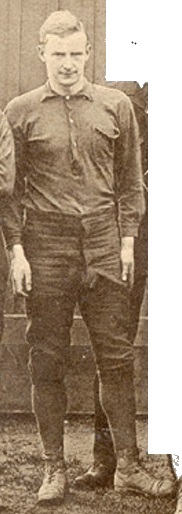 |
David Hislop (forward) Whit a fine figure of a man. Davie’s saying “don’t mess with me” as he looks you straight in the eye. This former Glasgow Royal player, born Percy David Hislop, committed himself to the Thistle cause as a teenager in the summer of 1888 and proved to be a great asset during his 2 full seasons with the club. Wisely, he never let on about the Percy bit, and gained the full respect of his team mates when he nabbed his first hat-trick in a tour match in September 1888 as Thistle trounced Ulster by 12 goals to 1. He repeated the feat in his second season, helping Thistle to a 5-2 win against Port Glasgow Athletic in October 1889. In all, the big man played at least 70 times in the dark blue and netted at least 25 goals, most commonly coming from out on the right wing. His talent didn’t go un-noticed and he was soon poached away by Rangers in the summer of 1890. He duly played with them in their first ever Scottish Football League season, 1890-91, and was a massive hit at Old Ibrox, virtually an ever present as he contributed 10 goals to their joint title winning campaign. He was then lured down South by Aston Villa before returning North to, of all places, Forfar Athletic. David is one of the super seven who contributed to all three victories against Rangers in season 1888-89. historians note: I’ve got a strong hunch that the “D. Hyslop” quoted as playing for Thistle twice in May 1887 is one and the same as this “David Hislop” My case file is very much open to the possibility that he was either a fringe member or perhaps even a miss-spelled guest at that time. Looking at the photo on page 146 of the History Book, I’d swear that was David Hislop sitting on the grass, front left as you look. Since that picture appears to be earlier than 1888-89, such a positive i.d. could perhaps strengthen this train of thought. |
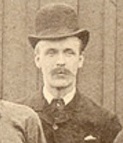 |
William Stirling (ex-player, Vice-President) This disciplined looking club member was a fringe player in terms of the first eleven, but his leadership qualities were such that, in his day, he was captain of the Second Eleven, or the Partick Thistle Swifts as they were known. He notably made 4 appearances for the first team in season 1882-83 – and had some tales to tell. It wasn’t entirely uncommon for outfield players to take a turn in goals if required, and William did this on two occasions. His second such stint was actually in the Scottish Cup in a 3-3 draw at home to Cambuslang in October 1882. As a result of one of the SFA’s quirkier 19th Century rulings, both sides progressed since it was the second time the tie had been drawn! The versatile William had two further successes in the springtime, playing at full back in a 2-0 home victory over Rangers in April, and then turning out at half-back in a 2-0 derby victory at home to Partick a month later. Our man went on to serve as a committee member throughout the latter half of the 1880s in various capacities including Vice-President and Honorary Secretary. |
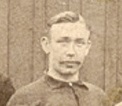 |
Andrew Mackay (forward) This pleasant looking fellow was listed as the vice-captain of the Swifts in season 1885-86. He displaced Willie Paul as centre forward for two appearances in the winter of 1886, in Glasgow derbies against the mighty Queen’s Park (1-3) and Rangers (0-0), but presumably didn’t impress enough to retain a first team place. In common with most forwards of the day, Andrew could play anywhere across the frontline, but was most commonly found in the inside right position. His main run in the first team came in season 1888-89 when he appeared at least 11 times, scoring twice. Both of his goals came in victories at Inchview. The first was in a crazy 7-6 win over Albion Rovers in January 1889 and the second in a 2-0 win against St Bernard’s, a month later. Andrew’s last known match as a first team player would have been a memorable one for the player himself – it came at Deepdale in April 1889 as the Jags boldly squared up to the Preston North End. They had just become England’s first League champions and also the first winners of “The Double”, becoming the only team to date to go throughout an entire season unbeaten in both the League and FA Cup. To boot, they had won the FA Cup without even conceding a goal: “Played at Preston before 6,000 spectators. The game was very keenly contested throughout, and the issue was in doubt right up to the finish. Preston did most of the attacking, but their efforts were repeatedly frustrated by the fine defence of the Scotchmen. In the end Preston gained a hard earned victory by 2 goals to 1.” Our Inchview banner lads clearly fought well against the very best of the best that the World had to offer at this time. As a side note, I’m quite amused by the fact that this report refers to Thistle as the Scotchmen. More than half of that Preston team were Scots! |
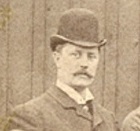 |
John N. Boag (ex-player, President) Now here’s a fellow who’d have been bound to give you the firmest hand shake you would’ve had for a long time. Quite possibly, you’d have got one of those funny hand-shakes too, while he was at it. As a player for Partick FC from the early 1880s, John was certainly no stranger to Inchview. When Partick FC folded at the tail end of season 1884-85, there were many who made the jump over to the Thistle. John was one such club member and he therefore became one of a select bunch to have played at Inchview for both the Partick and the Partick Thistle. By this time, his playing career was coming to an end but he famously made it onto a very special team sheet – appearing at outside right at Hampden in Thistle’s first ever match in the FA Cup; Queen’s Park 5, Partick Thistle, 1. Mr. Boag’s ambitions lay off-field however, and by season’s end he was elected as the club’s representative to the SFA. By the end of 1886-87, Mr. Boag was elected as club President. Reports said that “Boag is popular, and a good businessman, and will be able to conduct the affairs of Partick Thistle well.” He owned a Public House in Dumbarton Road and an Orange Hall in Rosevale Street, and these venues would often be the centre of the club’s social and business activities; visiting teams would be entertained post-match, players would partake in smoker’s evenings, concerts would take place and the club would conduct General Meetings therein. He retired his position as President in 1890, but remained heavily involved in the club’s advancement. He was a key figure in the club’s drive to become involved in organised League football and was so well respected in the game that he became Chairman then President of the Scottish Alliance, playing a political blinder to smooth the way for the eventual formation of a Scottish Second Division. It was thanks to the efforts of John Boag and Andrew Smith that Partick Thistle were at the very front of the queue for Scottish League admission when the chance came. |
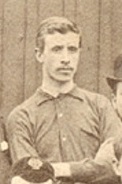 |
William Proudfoot (half-back) The first of the five Proudfoot brothers to sign up for Partick Thistle duty! He’d soon be followed by Lawrence, David, George and John. William joined the club from Partick Westburn in the summer of 1888 and was a mainstay for several seasons, albeit with a season break. He was renowned for his steady play and was looked upon as a safe player who could be relied upon and was duly appointed club captain in 1890. He gained representative honour when he turned out for Glasgow against East of Scotland in November 1891, a 2-2 draw at Celtic Park. There were calls for his inclusion for International trials, but these went unheeded by the selectors. By this time, William had taken up right back as his position of choice, although he could just as easily play on the left. Clyde had been after him for some time, and he was finally tempted away to Barrowfield Park for season 1892-93, where he mainly played at left-back, appearing 13 times in the prestigious Scottish Football League. He returned to Inchview for a second spell though, and played in the latter half of our first season in the brand new Scottish Football League Second Division. In this spell, he tried his hand for a run at inside left but had little success – with one very notable exception, as he played a huge part in Thistle’s all-time record League victory – a 13-1 victory over Glasgow Thistle. Our man bagged himself a hat-trick on the day, making an extra bit of Thistle history by being one of three players to score a hat trick in the same League game – an occurrence which remains unrepeated to date. For his final appearances late in 1894 he was back in his favoured right back role, and played a part in a terrific 1-0 victory over Rangers in the Glasgow Cup semi-final. Alas, it was to no avail as Rangers protested on the grounds that we had fielded an ineligible player, and the result was voided. In all, William appeared on at least 145 occasions and is the leading Proudfoot in this regard, although it would be his brother John that would take the family honours for leading scorer. William is one of the super seven who contributed to all three victories against Rangers in season 1888-89. |
 |
Charles McQuarrie (ex-player, Treasurer) Unfortunately, wee Charlie is found here competing for space with a beanpole and a man-mountain. Surprisingly, he was the only beardie at the time – but even that’s cut off. Tut. Aye, good one Mr. Photographer. Like many of the club’s members in the 19th century, Charlie’s ambitions to play football were perhaps not in line with abilities, and therefore other duties were performed for the love of Partick Thistle. Throughout the 1880s Charles served as Match Secretary, Treasurer and was the club’s representative at meetings of the Glasgow FA. As well as appearances in the second eleven, he made it onto the field as a first team player on two occasions in 1887, lining up both times as inside right to legendary club centre forward, Willie Paul. He played vs. Glasgow Thistle [a] 3-2 in April and vs. Renfrew [h] 1-2 in December. Won 1, Lost 1. For 4, Against 4. Perfectly balanced – just like his books! |
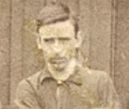 |
J. Kelly (forward) This rather shifty looking character has left next to no identity traces. Good job Kelly. What was his forename? Where did he come from? Where did he go? Nobody knows. He played mainly at inside left and appeared on at least seven occasions between February and May 1889, scoring at least twice. His known team record is rather decent – W5 D1 L1. Last known appearance? Partick Thistle 6, Rangers 2 on the 4th May 1889. Way to go JK. historians note: John Litster reports four J. Kellys in Scottish Football 1888-89, all played in the Scottish Cup. There was a James Kelly (Vale of Leven Wanderers); James Kelly (Newton Stewart Athletic); and both a John Kelly and a James Kelly (Erin Rovers). Niall notes that we had a trainer known as J. Kelly in season 1889-90, the chances are high he could be one and the same as our man. |
 |
Andrew M. Smith (Honorary Secretary) Andrew became part of the committee in 1884 and quickly demonstrated that he was able to take on the most demanding of roles and he soon became the secretary of choice come AGM time – despite his repeated attempts to step aside and let someone else take the bulk of the strain! Niall Kennedy: “At the club AGM in June 1893, Andrew Smith did indeed resign as secretary and was elected President of the club and presented with a purse of sovereigns in recognition of his past services. However, no volunteer could be found to take Smith’s previous secretaries post. Smith resigned after less than an hour as President, and resumed his role as secretary of the club.” Alongside John Boag, with whom he would undoubtedly have taken much counsel, one of Andrew’s greatest achievements was helping to reshape the course of Scottish Football – to the great benefit of Partick Thistle. Further to his election as President of the Scottish Alliance, it was he who presided over the master plan to amalgamate the Alliance with the Scottish League. As other clubs in the Alliance floundered with a mutiny, Andrew’s skilful manoeuvring ensured that Thistle were as good as “first through the door” when it came to the establishment of the Scottish Second Division. He was clearly a well-respected figure in the game as he was duly elected as the first President of the newly formed SFL Second Division. The summer of 1893 was as busy as it was fruitful for Andrew and for Thistle – it could arguably be viewed as the greatest close season in the club’s history. Andrew continued to serve Thistle in various committee roles, and saw the club all the way through to Meadowside and the first dalliance with the Top Flight in the late 1890s. |
 |
John Drummond (forward) Drummond, an Edinburgh-born lad, arrived at Inchview as a 20 year old, and mainly plied his trade on the right side of the forward line. He wasn’t here for too long and his 39 known first team appearances were crammed into the period April 1889 to May 1890. In that time he netted on at least 15 occasions, including a hat-trick at Cappielow against Morton in a 4-4 draw in November 1889. All of his known strikes came in the one campaign, and his 15 goal total gives him the proud accolade of finishing as our Top Scorer for the season 1889-90, breaking Willie Paul’s long run of 3 seasons as top cat. John’s exploits were such that the mighty Preston North End came calling at the end of that season and he was offski, further bolstering the Scots ranks at Deepdale. For them, he picked up where he left off at Inchview, scoring on his debut in The Football League against West Bromwich Albion on 13th September 1890. Wikipedia takes up John’s story to great effect: “Drummond was one of three players signed from Preston by Sheffield United in the spring of 1891 after chairman Charles Stokes decided the club needed to use its financial position to attract more capable players as the club looked for election to the Football League. He became a regular in the side for the following seasons and at the end of the 1892–93 season he scored the only goal as United took on Accrington in a test match which saw The Blades promoted to Division One for the first time in their history. Anecdotal reports of the match said that the pitch was in a terrible state and Drummond was almost the only player to be able to keep his feet, something that he attributed to painting the soles of his boots with black lead to prevent the mud from sticking. He went on to make 89 competitive appearances for the club and scored 24 goals. Drummond joined Liverpool in the summer of 1884 for whom he made 18 appearances in total, scoring one goal. After one season on Merseyside he returned to Yorkshire to sign for Barnsley St. Peter’s where he saw out the remainder of his career. Drummond had been an apprentice shipyard carpenter as a boy and returned to work in the Dumbarton shipyards after his retirement from football, reportedly working until the age of 78.” |
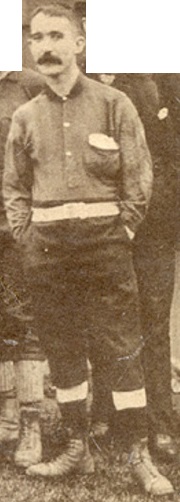 |
John Hendry (full-back) Gotta love Hendo, there he is, hands in pocket, relaxed as they come – if it wasn’t for that ‘tache you’d never think it was the 1880s. Along with Burnsy, he gets my vote as joint favourite. As this banner attempts to dig back as close as it possibly can to the very beginning of Thistledom, John is the oldest and best link that we’ve got. Here we have a man who played with Thistle in the public park days of the 1870s. John was the only player who could lay claim to having played at all 4 of our homes to date; Overnewton Park, Jordanvale Park, Muir Park and now, Inchview. John played at right back when Thistle won their first trophy – the West of Scotland Cup in 1879. The final was played in front of 400 spectators at the First Hampden Park on the 5th April 1879; Partick Thistle 1, Marchtown 0. The chances are high that he played in our very Scottish Cup match versus Jordanhill in October 1880, although no line ups have been unearthed for that one as yet. He was certainly there for the following round against Rangers a few weeks later. In fact, John was virtually an ever present all the way through the 1880s as Partick Thistle continued to develop into one of the most prestigious clubs in the country. To all intents and purposes, John seems to have been a one club man and appeared for the club on at least 166 occasions – an enormous total in an era when a huge number of team line ups were simply not recorded. Until such times as we discover evidence to the contrary, our man goes down as one of those “one goal wonders”. His goal came at Inchview in on the 2nd April 1887; he put Thistle 2-1 up in a 3-1 derby victory against Cowlairs. At the time of this photograph, John was also listed as being in the committee (along with Bob Robertson) and it’s my guess that these two might have been part of the “match committee” responsible for team selection. We probably weren’t old enough to have club legends in the late 1880s but if we did… |
 |
Jerry Suter (forward, Match Secretary) Jarvis “Jerry” Suter, more often than not a left sided forward, was another of those who could qualify as a bit of an early Thistle legend, making at least 149 appearances between 1882 and 1890, notching up at least 46 goals in the process. Again, it should be emphasised that many goal scorers in these days went unreported and almost certainly do not reflect the full extent of each player’s prowess. Nonetheless, his known 11 goals total in season 1884-85 is enough to give him the accolade of Top Scorer for that campaign. His talents at that time were recognised by the Glasgow FA and he was selected to play against Dunbartonshire in October 1884, scoring twice in a 3-3 draw. Alongside him that day were fellow Jags Andrew Duff, John Hendry, Jack Beattie and Bob Robertson. Jerry was honoured with two further appearances for Glasgow in February 1887, again scoring vs Edinburgh (L2-3), and providing assists vs Sheffield (10-3). Amongst his many scoring highlights for Thistle were 3 career hat-tricks including one in the FA Cup (11-1 vs. Cliftonville, Dec 1886) and one in the Scottish Cup (10-0 vs. Westbourne, Sep 1887). His strong commitment as a Jags man was underlined in the mid-1880s when he accepted the dual role of Player / Match Secretary, taking chief responsibility for arranging a fixture card which was as attractive as possible for the treasurer. |
 |
Bob Robertson (half-back) Boab is another right up there with the Hislop, giving it the big “don’t mess” vibe. He first appeared in 1883 and went on to rack up at least 196 appearances for the club over the course of the next ten years, with spells as club captain. It’s a virtual certainty that, in actuality, his tally would be way over the 200 mark. His successful Thistle career was underlined by the fact that he played three times for the Glasgow FA; vs. Dunbartonshire in 1884 (3-3), and against Sheffield in both 1887 (10-3) and 1889 (8-1). He started out as a half-back in 1883, although he went on to have long spells as a full-back and even played in forward roles, as and when required. He was always keen on getting forward and was noted for having decent shooting ability – evidenced by his impressive haul of at least 43 goals for the dark blues. A great highlight for club and player came in March 1885 at Muir Park when Renton arrived for a Grand Challenge match, just three weeks after having been crowned Scottish Cup “champions”. This was a real glamour occasion for Partick – and a rare coup for the match secretary and the treasurer. Thistle, trailing 1-0 at half-time, came from behind to secure an infamous victory by 2 goals to 1. It’s said that the winning goal was a real team effort in a move that involved Willie Paul, Bob Robertson and James Miller, the latter doing the needful with his head. Brilliantly, the Scottish Umpire was moved to comment: “The scene that ensued almost baffles description – men, women and children giving vent to one exultant yell.” These were the deeds that were important in moving the club forward, instilling a great sense of pride locally as well as raising Partick Thistle’s stature on a countrywide level. Bob is one of the super seven who contributed to all three victories against Rangers in season 1888-89. |
 |
William Hay (full-back) William’s stint at Inchview was a relatively short one, with all 16 of his known appearances coming between December 1888 and May 1889, the undoubted highlight of which was a 4-2 victory at Old Ibrox in February. Perhaps he played too well on that occasion – by season’s end the mob from Govan had coaxed him over to the dark side. For years, the Govanites had never managed to win even a single match at Inchview – their desperate response was to start poaching the talent! |
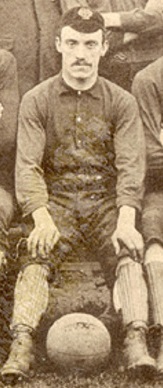 |
Andrew Johnston (forward) Our wee Eddie Gallagher look-a-like is proudly showing one off his City caps here. His striking prowess was recognised by the Glasgow FA and he represented the club in three matches; vs London in November 1886 (2-2) and twice vs East of Scotland in February 1888 (1-1) and February 1889 (3-5). Andrew’s first known appearance was at Inchview on 31st January 1885, when he lined up as outside right vs. Kilmarnock Athletic. Playing at centre forward was our eccentric goalie, Andrew Duff, who also got onto the score sheet. There were no goals for our Andrew though, but the Jags ran out winners by 5 goals to 0. The goals weren’t long in coming for the wee man though – there were at least 66 of them over the course of the next 6 years – and he outscored Willie Paul in what was the debut season for both forwards. In fact, Andrew’s first season total of at least 13 goals (all post-January) was enough for him to claim the crown as Top Scorer – not a bad start to his career. Andrew bagged at least 3 hat tricks in his time at Thistle, including a 4 goal haul in the 12-0 Scottish Cup mauling of Alloa Athletic in October 1885. On a personal level, Andrew might have felt some degree of satisfaction when he scored a first half equaliser at Deepdale in April 1889, for the Preston North End had just completed the “double”, were nicknamed “the Invincibles” and were considered the finest club side in Britain at the time. The goal looked to have given Thistle a famous draw until the home side snatched a winner at the death. Still, it was one he could tell the grandchildren. Later, Andrew signed up with Third Lanark as they geared up to compete in the inaugural Scottish Football League season of 1890-91. He was always welcome back at Inchview though – and would occasionally return as a guest and for the odd benefit match. Andrew is one of the super seven who contributed to all three victories against Rangers in season 1888-89. |
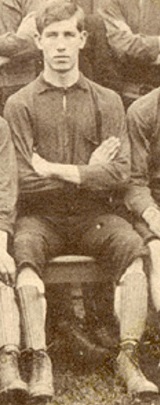 |
Thomas Campbell (full-back) Thomas served 4 solid seasons for the cause from 1888-89, appearing on at least 65 occasions. A career low point for player and club undoubtedly came in his final season – a 3-0 home defeat to Hurlford in the Scottish Cup 2nd Preliminary Round in September 1891. As was normally the case with sides from Ayrshire, it was a rough battle full of nasty incident. Sending offs were far less common in the days when charging was largely a tolerated aspect of the play. However, that day Thomas was sent off along with Cosgrove of Hurlford. Niall Kennedy: “At the disciplinary meeting after the game, the referee accused both players of fighting. Campbell responded by saying that he had never been accused of rough play before, and if it had not been for his smartness in avoiding Cosgrove’s butting head he would have been carried off the field, Cosgrove denied butting, but admitted charging. Both players were censured.” On a more positive note, he can claim to have played for Thistle in our first ever League match in 1891, before going on to rack up 15 appearances in that inaugural Scottish Alliance campaign. Thomas signed for Glasgow Thistle in the summer of 1892 and went on to play with them in the first ever SFL Second Division season of 1893-94. Ooft. They were a doomed concern. Bad move Thomas. |
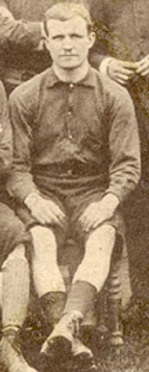 |
George Ward (half-back) George was the second of three Ward brothers to appear for the club. He was preceded by his brother James a few years earlier, and William, several years later. William would later become club president and was, I think, the first chairman of the new Partick Thistle Football Club Limited in 1903. You can read an interesting interview with William here. All of George’s 27 known appearances were registered in season 1888-89. The half-back managed to get himself on the score sheet at least once – he slotted home the crucial 10th in a 12-1 tour victory away to Ulster! George is one of the super seven who contributed to all three victories against Rangers in season 1888-89. |
The full story of how these players and the club fared in 18889-89 can be read here. Thanks to Stu’s Partick Thistle Archive for the photos on this page.
One Response to The Inchview boys are in town
Leave a Reply Cancel reply
Categories
- Miscellaneous (16)
- Other clubs (15)
- Players (26)
- Thistle – early years (48)
- Thistle – general (5)
Football history links
- Ayr United archive
- Bill Shankly
- Falkirk Historian
- Gallant Pioneers – Early history of Rangers
- Glasgow Herald archive at Google
- Hibernian
- Hibernian Historical Trust
- London Hearts
- Partick Thistle history archive by StuTheJag
- Rangers History
- Scottish Football Historical Archive
- Scottish Football Museum
- Scottish Sports History
- ScottishLeague.net and forum






It was a privilege to read the story, really engrossing.Our family have been Jagsmen for 5 generations (Andrew/Dickie)and my grandpa George Andrew and his son Jim always went to the “new Firhill” to what they described as bawling their lungs out to support the boys, some days these!!! Grandpa George had a tobacconist shop in Whiteinch for years and it was quite near Inchview. I never met him and would have loved to and have a good chat….. thanks again kind regards George